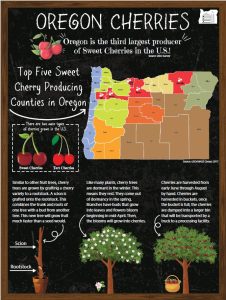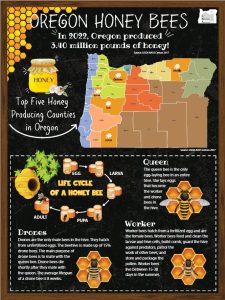This 2-sided 18×24″ poster features Oregon’s cherry industry and the life cycle of Honey bees. A great additional to celebrate the upcoming Spring season.


Students read How to Grow a Monster, describe the needs of a zucchini plant, identify the structure and function of zucchini plant parts, grow classroom zucchini plants, and experiment with different environments and growing conditions. Kit includes a copy of the book, How to Grow a Monster, cups and seeds for a class set of 25 students. This kit does not need to be returned. Limit 1 per class.
Peter Riley
This series is an introduction to the key science subjects, explaining the main scientific principles and showing how they work. Plant Life details the variety of plants in the world and how they grow and fertilize.’
This book must be returned
Cris Peterson
Seed. Soil. Sun. With these simple ingredients, nature creates our food. This beautifully written book by Cris Peterson, brings both wonder and clarity to the subject of agriculture, celebrating the cycle of growth, harvest, and renewal. The photography that conveys this story is a perfect fit for this story. The companion book to the Seed, Soil, Sun lesson plan and the Seed, Soil, Sun Kit. Please check the kit out separately.
In this kit, students learn what a plant need to grow and thrive, represented by a growing bracelet; each different colored bead is what a plant needs to live, and pipe-cleaner is the plant. Click here for the downloadable lesson plan. This kit includes one pipe-cleaner and six different colored beads per student.
This kit does not need to be returned.
This Kit Includes:
Pipe cleaners, beads, and a paper lesson plan
Please put the number of students in your class in the quantity section at checkout to ensure the correct number of supplies gets to you.
(Grades K-2) Enjoy sweet or spicy microgreens with students! Students will explore plant needs and grow a tasty treat for them to enjoy! This kit includes seeds, nesting container, planting container, germination cover and Mighty Microgreens booklets. This kit contains a class set for 25 students. This kit does not need to be returned. LIMIT ONE PER ORDER.
Martin Hutten, Karen Hutten, Andrea Woodward
This fun field guide will help students learn about the many different types of mosses, liverworts and lichens! The descriptions are very user friendly and include up-close pictures of each different plant form with details on their purpose and where they can be found. This item will need to be returned.
Ruth Spiro
Maxine and her friend Leo are makers. Maxine’s style is functional. Leo’s style is artistic. Together, They’re determined to make one spectacular garden, including a pond for Maxine’s fabulous goldfish Milton! But their garden attracts all sorts of visitors, with rabbits and squirrels and raccoons feasting on their veggies. Now Maxine and Leo must work together to try (and try and try again) to find a way to save their garden.
Perfect for STEM and maker spaces, this book is sure to inspire creative thinkers and tinkerers everywhere!
This book needs to be returned.
Oregon Forest Resources Institute
This revised and updated publication is designed to assist forest landowners, land managers, students, and educators in understanding how forests provide habitat for different wildlife and plant species. It describes the specific habitat requirements of selected species found in forested habitats across all ecoregions in Oregon. It provides teachers and students a way to learn more about wildlife species and the forest habitats they use and helps landowners and land managers determine what species to include in their management plans.
Shelley Rotner, Gary Goss
The supermarket is the place where you buy your food, but have you ever wondered where you favorite foods really come from? A lot of food comes from plants or from animals. but it might surprise you to know that some of the food you eat comes from bees or from seawater. Where does you favorite food come from? Find out in the fun, colorful, easy to read book!
This book needs to be returned.